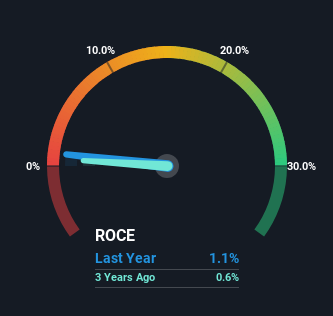Some Investors May Be Worried About Asia Cassava Resources Holdings' (HKG:841) Returns On Capital

If we want to find a stock that could multiply over the long term, what are the underlying trends we should look for? Ideally, a business will show two trends; firstly a growing return on capital employed (ROCE) and secondly, an increasing amount of capital employed. This shows us that it's a compounding machine, able to continually reinvest its earnings back into the business and generate higher returns. However, after investigating Asia Cassava Resources Holdings (HKG:841), we don't think it's current trends fit the mold of a multi-bagger.
What Is Return On Capital Employed (ROCE)?
Just to clarify if you're unsure, ROCE is a metric for evaluating how much pre-tax income (in percentage terms) a company earns on the capital invested in its business. Analysts use this formula to calculate it for Asia Cassava Resources Holdings:
Return on Capital Employed = Earnings Before Interest and Tax (EBIT) ÷ (Total Assets - Current Liabilities)
0.011 = HK$15m ÷ (HK$2.0b - HK$679m) (Based on the trailing twelve months to March 2023).
Therefore, Asia Cassava Resources Holdings has an ROCE of 1.1%. In absolute terms, that's a low return and it also under-performs the Food industry average of 8.9%.
View our latest analysis for Asia Cassava Resources Holdings

Historical performance is a great place to start when researching a stock so above you can see the gauge for Asia Cassava Resources Holdings' ROCE against it's prior returns. If you'd like to look at how Asia Cassava Resources Holdings has performed in the past in other metrics, you can view this free graph of past earnings, revenue and cash flow.
What The Trend Of ROCE Can Tell Us
In terms of Asia Cassava Resources Holdings' historical ROCE movements, the trend isn't fantastic. To be more specific, ROCE has fallen from 2.5% over the last five years. However, given capital employed and revenue have both increased it appears that the business is currently pursuing growth, at the consequence of short term returns. And if the increased capital generates additional returns, the business, and thus shareholders, will benefit in the long run.
On a related note, Asia Cassava Resources Holdings has decreased its current liabilities to 33% of total assets. That could partly explain why the ROCE has dropped. What's more, this can reduce some aspects of risk to the business because now the company's suppliers or short-term creditors are funding less of its operations. Since the business is basically funding more of its operations with it's own money, you could argue this has made the business less efficient at generating ROCE.
What We Can Learn From Asia Cassava Resources Holdings' ROCE
While returns have fallen for Asia Cassava Resources Holdings in recent times, we're encouraged to see that sales are growing and that the business is reinvesting in its operations. And there could be an opportunity here if other metrics look good too, because the stock has declined 69% in the last five years. So we think it'd be worthwhile to look further into this stock given the trends look encouraging.
One more thing: We've identified 3 warning signs with Asia Cassava Resources Holdings (at least 2 which are a bit unpleasant) , and understanding these would certainly be useful.
For those who like to invest in solid companies, check out this free list of companies with solid balance sheets and high returns on equity.
If you're looking to trade Asia Cassava Resources Holdings, open an account with the lowest-cost platform trusted by professionals, Interactive Brokers.
With clients in over 200 countries and territories, and access to 160 markets, IBKR lets you trade stocks, options, futures, forex, bonds and funds from a single integrated account.
Enjoy no hidden fees, no account minimums, and FX conversion rates as low as 0.03%, far better than what most brokers offer.
Sponsored ContentNew: Manage All Your Stock Portfolios in One Place
We've created the ultimate portfolio companion for stock investors, and it's free.
• Connect an unlimited number of Portfolios and see your total in one currency
• Be alerted to new Warning Signs or Risks via email or mobile
• Track the Fair Value of your stocks
Have feedback on this article? Concerned about the content? Get in touch with us directly. Alternatively, email editorial-team (at) simplywallst.com.
This article by Simply Wall St is general in nature. We provide commentary based on historical data and analyst forecasts only using an unbiased methodology and our articles are not intended to be financial advice. It does not constitute a recommendation to buy or sell any stock, and does not take account of your objectives, or your financial situation. We aim to bring you long-term focused analysis driven by fundamental data. Note that our analysis may not factor in the latest price-sensitive company announcements or qualitative material. Simply Wall St has no position in any stocks mentioned.
About SEHK:841
Asia Cassava Resources Holdings
An investment holding company, engages in the procurement, processing, warehousing, and sale of dried cassava chips in Mainland China, Hong Kong, and Thailand.
Slight and slightly overvalued.


